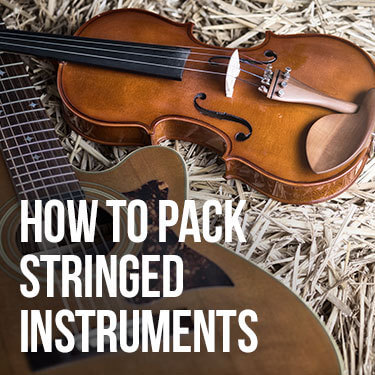Shipping musical instruments in bulk can be a nerve-wracking experience if you’ve never done it before. If you're a musician yourself, then you are well aware of how fragile instruments can be. The last thing you want to happen is for them to be damaged during their journey.
According to Sweetwater, shipping musical instruments should start with filling in empty spaces inside the case with packing material. Pack the case into one box and repeat the process of filling spaces with packing material. Afterward, put the first box into a larger one for more security and obtain shipping insurance.
In this guide, we will cover how to ship musical instruments, including shipping rates, how to pack them and more.
When shipping instruments, you can expect to pay anywhere between $7 and $1,000+ per instrument. How much you pay ultimately comes down to a few different factors.
Many shipping companies will measure the dimensional weight and actual weight of packages. The dimensional weight is estimated based on the width, length and height of the package carrying your musical instrument. The actual weight is how heavy your musical instrument is once it's packed up.
If your instrument requires a box with large dimensions that have a heavier estimated weight than the actual weight then the dimensional weight will be applied to your shipping costs. Likewise, If the actual weight of your instrument is heavier than the dimensional than the actual weight is applied to your shipping costs instead.
The destination of your shipment will also affect how much it costs to ship your instrument. Shipping companies use the distance a shipment will travel to determine the shipping zone.
There are eight shipping zones in total and the higher the shipping zone, the more miles your shipment will travel. Shipments that use higher shipping zones will be more expensive.
Lastly, every carrier will offer slightly different rates. The table below shows the weights of common instruments and estimates of the standard cost of shipping packages that correspond with that weight.
| Instrument | Weight | Standard Cost Estimate |
| Piccolo | 1.25 pounds | $7.00 |
| Flute | 1.13 pounds | $7.00 |
| Clarinet | 2 to 5 pounds | $7.55-$8.00 |
| Bassoon | 7.5 pounds | $8.35 |
| Snare | 10 to 18 pounds | $9.70-$15.80 |
| Tambourine | 3 pounds | $7.80 |
| Maracas | 0.87 pounds | $2.75 |
| Guitars | 2 to 12 pounds | $7.60-$12.40 |
| Violin | 1.1 pounds | $7.00 |
| Cello | 5 to 7 pounds | $8.00-$8.40 |
| Ukulele | 0.5 to 0.87 | $2.75 |
When shipping musical instruments in bulk, you can use these estimates as a way to calculate the cost of your entire shipment. It’s worth noting that companies will often offer more favorable rates for larger shipments.
Musical instruments are divided into four different families. These four families are called woodwind, brass, percussion and strung. Each type of instrument will require unique and special care when preparing to be shipped.

No matter your instrument’s level of quality, and regardless of what family of instruments it belongs to, there are a variety of items you’ll need in order to prepare it for shipment. Those items include:
Packing large amounts of instruments properly is imperative to their safety. Given how long shipping delays have been recently, it may take a while before your bulk load of instruments arrive at their destination.
The longer your instruments are away, the more likely they could be damaged. That is why you need to make sure that they’re packed safely and securely.
Shipping delays could extend the amount of time your instruments spend in transit which also increases the likelihood of damage occurring. This makes packing your instrument securely all the more important.
If you’d like more information on shipping delays, check out our article What’s the Deal with Freight Shipping Delays?
Start preparing your woodwind or brass instruments for shipment by first disassembling it. Place these loose items in bubble wrap or other packing material and put them in the storage compartments of the case.
Place the instrument into its case and fill in any spaces with packing materials like kraft paper. This is important because you want your instrument to move as little as possible while it is in transit.
While not recommended, shipping woodwind and brass instruments without cases is possible. If you take this route you should wrap each part of the instrument at least three times with bubble wrap. After wrapping, use shipping tape to keep the bubble wrap fastened around the instrument and its parts.
Afterward, use a double corrugated box or a regular box that is slightly bigger than your instrument. If you’ve sealed your instrument into a regular box you will have to place and seal it into a slightly larger box.
While packing your instruments is important, having a good driver behind the wheel goes a long way. Fortunately, R+L Global Logistics has a great lineup of safe truck drivers in our ranks
While musical instruments of any type can be fairly expensive, percussion instruments are notorious for costing a good amount of money. That is why packing percussion instruments correctly is so important. Many percussion instruments, like the drum kit, have a packing process that is completely different from other instruments.
The first step you must take to prepare drum kits for shipment is to take the kit apart. This includes removing the legs, the rack for the toms, mounting brackets and the pedals for the hi-hat and kick drum.
Once you have disassembled these smaller pieces of the drum kit, you can either wrap them up in packing material, like bubble wrap, or place them inside cases. There are a few ways that you can pack the different types of drums that make up a drum kit for shipment. Whichever one you use will keep your instruments safe.
The reason this is called the separate method is that you will ship each part of the drum kit in separate boxes. The first step you should take is to remove the head of the snare, toms and kick drum.
To do this, you will remove the head of the drums and line the inside of them with strips of cardboard. Once you've secured the lining of the drums, use kraft paper to fill in the space within the drum. After the inside of the drum is secured, you can reattach the head of the drums.
When the inside of the toms, bass and snare drums are secured, you will place them along with the cymbals and hi-hat in their respective cases. From here, you will secure any spaces within the case.
To give your cymbals some extra protection, wrap them in bubble wrap before you place them into their case.
The nesting method is a great way to not only ship a drum set, but also save space. The reason it is called the nesting method is that you will be placing the smaller tom drums within larger ones and then storing them all inside the kick drum.
The first step of the nesting method is to secure the inside of the smallest tom by removing the head, adding packing material to the inside and then reattaching the head. When the inside of the smallest tom drum is secured, you will place it inside the next largest tom drum.
The larger tom drum needs to already have packing material at the bottom. Fill in any space between the outside of the tom and the inner wall of the larger tom with packing material like kraft paper. Continue the process until the largest tom has all of the smaller ones within it.
Once the toms have been secured, you will place them into the kick drum. The kick drum’s head must be removed so that packing material can be placed at the bottom.
Next, you will place the toms within the kick drum and secure any space. After this you will reattach the head to the kick drum.
Lastly, you will place the kick drum into a box where it will need to be secured. Once again, you will fill in any space between the kick drum and inside of the first box’s wall. Repeat the same process of filling spaces when you put the smaller box within the larger one.
You can ship the kick drum within a case with all the toms in it as well. The cymbals and high hat will have to be packed and shipped separately.
When packing xylophones, vibraphones, marimbas and glockenspiels, you will start by disassembling the stand that holds them up. Next, take the bars off the instrument and wrap them up separately.
Wrap each bar up separately with some type of packing material like newspaper, kraft paper, or bubble wrap. You can store these bars within a soft-sided case or a box large enough to fit them but small enough to keep them secured.
Pack the frame and the resonators carefully within their cases and fill in any space with packing materials. Use this bulleted list to help keep track of your progress when you pack these instruments:
Getting fragile instrument parts like these to their destination safely requires the skill of an experienced driver.

Packing a stringed instrument for a shipment is similar to packing woodwind and percussion instruments. However, due to the fragile nature of stringed instruments, you will have to follow some unique guidelines.
Some of the most popular and recognizable stringed instruments are guitars and basses. These two particular instruments are in high demand for experienced and beginner players, alike.
Before packing a bulk shipment of guitars and basses, the first step that you should take is to remove any items or accessories that don’t need to be on them. Wrap these items with bubble wrap and place them in the storage compartments of the case.
Loosen the strings of the guitar or bass to help ease tension on the neck and wrap the head of the instrument with bubble wrap. After the head has been wrapped with bubble wrap, put some rubber bands around it to keep the bubble wrap from coming loose. For the next step, place kraft paper in between the strings and the fretboard of the instrument.
Securing the instrument in the case will be the same process that you must follow for woodwind and percussion instruments. Any empty spaces in the case need to be filled with kraft paper to prevent any movement while the instrument is in transit.
When you're shipping large quantities of violins, violas or cellos, you will need to loosen the strings and lower the bridge. The bridge of these instruments should be wrapped in tissue paper or cloth and then placed beneath the instrument’s tailpiece.
After this, you can retighten the strings just enough that it will keep the bridge in place. Lastly, you will need to wrap the head of your instrument with tissue paper. After placing it in the case, begin to fill in any empty spaces.
Once all spaces have been filled, place tissue paper between the fretboard and strings.

One process that will remain the same when you're shipping musical instruments, regardless of what kind, is the way you will secure their cases in the boxes that you place them in. When you place the case into the smaller box, there will likely be some space left over.
You will need to secure this space with packing materials. You can use any type of packing material from air pockets, packing peanuts, bubble wrap, kraft paper or newspaper.
After the case is secured, you can seal the first box. Then you will repeat the process when you place the first box holding the case into the second box. Fill in any spaces with packing material and then seal it.
This checklist will guide you through the process:
When you make bulk shipments, you should always use a pallet. However, due to the dimensions of some instruments, the large quantities of instruments that you ship might have to be floor-loaded. To find out more about palletized and floor-loaded freight, read our article Floor Loaded vs Palletized: Which is Right for You?
Properly preparing and packing your instruments will give them protection from any potential damage that could occur. However, there’s still a possibility that your instruments could still sustain some type of damage.
Obtaining insurance for your instrument might bring up the cost of your shipment, but it is well worth the added protection. An instrument that gets damaged will make your shipping more costly than it would just to add insurance to the total cost of your shipment.
Luckily, at R+L Global Logistics, we offer insurance for shipments of all kinds.
At USA Truckload shipping, you won’t find a more dedicated team to handle your bulk shipment of instruments. We have a talented team that will make sure that your instruments will be loaded, transported and then unloaded safely and efficiently.
We’ve helped customers move their freight from Point A to Point B for years. During that time, we have formed relationships with many reliable and trustworthy partners. With our connections and logistics expertise, you can count on your shipment arriving at its destination at an affordable price.
Fill out your free quote today and get your instruments to a music store and into the hands of eager players today.
R+L Global Logistics
315 NE 14th St., Ocala, FL 34470